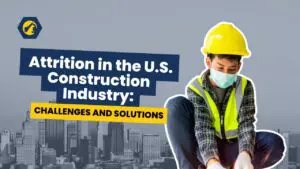The construction industry has traditionally been fraught with poor quality of life issues, stemming primarily but not exclusively from long hours (per day and per week) compared to other sectors of society, and the resultant stress this can cause. When it’s the busy season, a deadline is looming on the horizon, or an emergency arises, construction managers may be called upon to work 60 or even 80 hours in a week. This is particularly true in the heavy civil sector, where projects may be spread far and wide, and are not confined to urban areas or regular hours. Travel is often required, between the office and job sites, and between one job site and another. While all this translates as less time spent at home and pursuing hobbies and interests, it may also mean greater stress. Not surprisingly, construction managers experience higher stress levels and below average flexibility (alternative working schedule and work-life balance) compared to other jobs, according to US News and World Report.
This is changing, however. With a shortage of qualified workers to replace the rapidly retiring Baby Boomers who make up the majority of the construction workforce, companies are beginning to rethink company culture and values in their quest to court the next generation. Millennials (born between 1981 and 1996) already account for the majority of people in the U.S. workforce at large (over half of whom are managers with the power to make decisions and generate reports). If the construction industry wants to survive, it will need to find ways to attract more of these workers, who have different expectations than their predecessors and have proven to be less inclined to enter the construction industry as it has traditionally operated.

In the near future, it’s likely that new hires in construction will find attractive benefits accompanying their jobs, benefits which value and support the concept of work-life balance (WLB), such as childcare services, mental health and wellness services, maternity and paternity leave, eldercare assistance, and availability of flex time and leave time. Some companies have already introduced compressed work weeks and flexible work schedules, helped along by the recent Covid-19 crisis. Until the construction industry catches up with other sectors of the marketplace however, what steps can you take personally to improve your work-life balance?
For those working in the construction industry today, here are some suggestions:
- Prioritize the quality of your tasks, both personal and work related. Give those that are most important the most time. Not all tasks need to be done perfectly and the cost/benefit ratio isn’t worth it.
- Delegate what you don’t need to do yourself. Again, this applies to both work (give tasks to your assistants) and home (hire a part time housekeeper, gardener, etc if necessary) to give you more time to spend doing what’s really important, including down time.
- Resist the impulse to be available to your boss 24/7. Don’t respond to emails sent late at night (don’t even check work email late at night) unless you are working under a deadline.
- Along those lines, avoid taking work home with you on a regular basis. If you are working from home, this means set aside periods of time you will work and stick to the schedule.
- Practice some sort of relaxation technique when feeling stressed, like meditation, yoga, tai-chi or even taking a short walk outdoors.

Make a clear distinction between work and personal life and make it a policy not to overlap the two unless it’s absolutely necessary. This may sound impossible to some people, and oversimplified to others, but it’s one of the most critical and useful tactics in creating a successful work-life balance. When spending time with family, don’t check work emails, take calls from colleagues, or work on reports, for instance. When at work, restrict your time phoning home to breaks and keep it short as a rule. If you are working from home, don’t try to interact with the kids, cook dinner etc while simultaneously participating in a conference call. Dedicate your allotted time as “work” or “personal”.
- If you can, opt for a compressed work week (four 10-hour days or three 12-hour days for instance) and/or flexible work hours. Research has indicated that alternative work schedules which include flexible hours and compressed work weeks have a positive effect on work-life balance of construction workers. You may want to consider any number of combinations: working 8-hour days Tuesday through Saturday; working Monday through Thursday, 10-hour days; working early mornings and late afternoons with a break in the middle of the day. Adopting policies like these allow you to attend your child’s sporting event in the middle of a Wednesday afternoon, for example, or a Saturday morning visit to the office (actual or virtual) while the kids are still asleep, or three long days of working followed by four days off. You may need to try one or more schedules to find what works best for you, taking into consideration both your professional and personal circumstances.
- Lastly, take advantage of any perks your employer may offer, such as childcare or eldercare assistance, mental health and wellness services, and maternity/paternity leave. Consider asking for these or other services you would benefit from if they aren’t currently on offer.
The construction industry has felt the impact of the recent pandemic as keenly as any other. Changes that began gradually have been accelerated by the need to stay safe. As a result, this industry long reputed to be high stress and demanding in exchange for higher than average wages and upward mobility is beginning to weave the values of a new generation into its corporate fabric. Remote work, less rigidity in the number and structure of hours, and increased use of time saving technologies, both in and out of the office, are most likely here to stay. Take advantage of these changes and the suggestions listed above to improve your own work-life balance.
Sources:
https://money.usnews.com/careers/best-jobs/construction-worker
https://www.tandfonline.com/doi/abs/10.1080/01446190802389402






